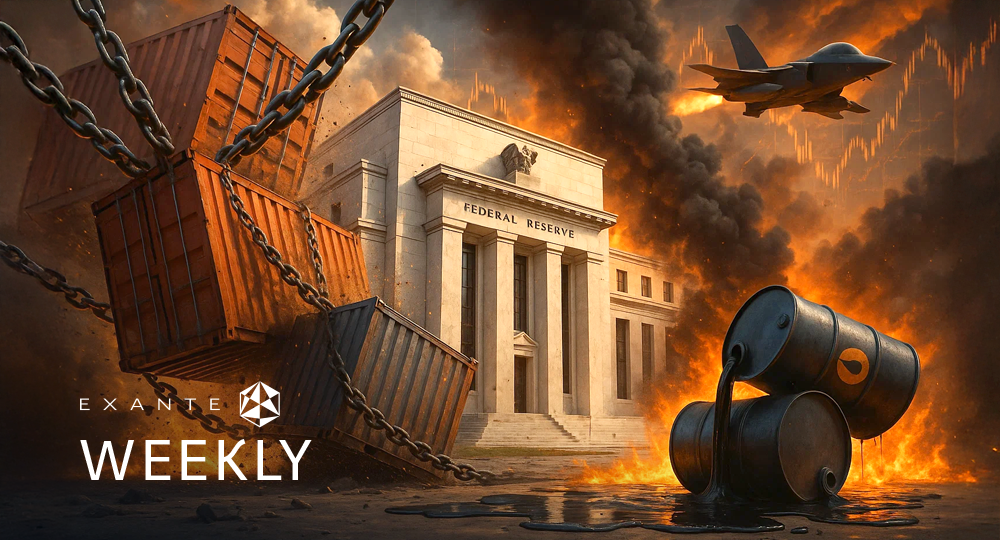By Renée Friedman, PhD
The week in summary:
Welcome to Macro Insights #16. This week saw markets reacting to ongoing geopolitical tensions, rising energy prices, strong labour market conditions, and growing consumer demand.
Treasury yields and stocks markets have had a very uncertain week in the US. On Monday St. Louis Federal Reserve President James Bullard reiterated his call for a faster rake hike timeline and said the central bank's "credibility is on the line" in its battle against rising prices. However, FOMC minutes from last month’s meeting were released on Wednesday and showed that while policymakers agreed that it would "soon be appropriate" to raise the Fed's benchmark overnight interest rate from its near-zero level, they would re-assess the rate hike timeline at each meeting. The fact that the Fed was not as hawkish as some had feared helped stocks recover somewhat as investors reacted to the ongoing geopolitical tensions between Ukraine, Russia, the US and NATO. However, strong retail sales data, i.e. 3.8%, almost double the 2% consensus figure, rising producer prices, e.g. up 1.0% in January and a continuing tight labour market, e.g.. the number of Americans filing new claims for jobless benefits is at a seasonally adjusted 248,000,a level most will associate with tightening labor market conditions, reinforces expectations that the Fed may be more inclined to aggressively hike key interest rates. All of these factors have resulted in US stock markets losing ground as investors also contemplate the increasing likelihood of pressure on profit margins due to these tight labour market conditions and the rising wage inflation that may follow,
The ECB has sent out a series of mixed messages this past week: on Monday ECB President Lagarde said that inflation risks are skewed to the upside but the ECB aims to maintain flexibility and policy decisions in March will depend on incoming data and “"any adjustment to our policy will be gradual.” On Tuesday ECB board member Isabel Schnabel and French central bank governor Francois Villeroy de Galhau said that they were open to winding down the Asset Purchase Programme (APP) which is a precondition set by the ECB for raising its interest rates. Villeroy de Gaihau said he could see it ending in Q3; it is currently expected to run until at least October. He added two of the three conditions set by the ECB for a rate hike had been met as headline and core inflation were above or around 2%. On Wednesday ECB governing council member Martins Kazaks said the ECB is “quite likely” to lift interest rates in 2022 to combat an unprecedented surge in euro-area prices but mustn’t “rock the boat” as it tightens monetary policy” while on Thursday, Governor of hte Bank of Spain, Pablo Hernandez de Cos said that any premature tightening of monetary policy would only hurt the economy and stimulus should be withdrawn gradually. As a result of this week’s mixed messages, Germany’s 10-year government bond yield, the benchmark of the Eurozone bloc, fell 1 basis point to 0.27%, after hitting its highest since December 2018 at 0.33% on Wednesday, while Italy’s 10-year government bond yield fell 4 bps to 1.87% on Thursday. European markets meanwhile have also been affected by ongoing tensions with markets falling as they worry about ECB tightening and the impact it will have on some sectors, particularly tech stocks.
Oil markets were generally up again this week despite a tweet from Iran’s top nuclear negotiator, Ali Bagheri Kani, that efforts to restore the country’s nuclear deal with world powers are “closer than ever” to an agreement, as there were conflicting reports about “de-escalation” in the Ukrainian situation and winter storms in the US raised demand. However, as reported by Bloomberg, Dated Brent, the price of cargoes bought and sold in the North Sea, reached $100.80 a barrel on Wednesday for the first time since 2014, according to S&P Global Platts. Dated Brent reflects how traders are willing to pay up to secure actual barrels for delivery to refineries.
Things to look out for this coming week
- In Europe on Friday is the French unemployment rate and CPI data. On Monday look out for German and French Markit manufacturing PMIs, PMI Composite and Markit Services PMIs, German producer price data, and Eurozone Markit PMI Composite, Manufacturing PMI, and Services PMI. On Tuesday there is Italian CPI data and German IFO Business Climate and Expectations data. On Wednesday is German GfK Consumer Confidence Survey data. There is also Eurozone HICP data which will be critical to the ECB as the data measures changes in purchasing trends and inflation in the EuroZone. On Thursday there is French Consumer Confidence data and Italian Industrial sales data.
- In the US on Friday look out for existing home sales data, Consumer confidence, and the Fed Monetary Policy Report to Congress. On Tuesday there is housing price index data, Markit PMI Composite, Manufacturing PMI and Services PMI data as well as Consumer Confidence Survey data. On Thursday there is a slew of data including the Chicago Fed National Activity Index, Continuing and Initial jobless claims, Core personal consumption expenditures and Personal Consumption Expenditure prices data, and New Home sales data.
- In the UK on Friday there is retail sales data. On Monday there is Markit Manufacturing PMI and Services PMI data. On Wednesday is the Bank of England’s monetary policy report hearings with the Treasury Select Committee.
On Monday is the People’s Bank of China (PBoC) interest rate decision. Following on from the collapse of Evergrande late last year which devastated the property market, the continuing zero tolerance policy with Covid and amid concerns over slowing GDP and retail sales growth, the PBoC has been cutting rates on medium-term lending facility loans and the seven day reverse repurchasing rate.
Financial stability, regulators and the crypto conundrum
On Wednesday the Financial Stability Board, which makes recommendations to the G20 nations on financial rules, said policymakers must act quickly in creating rules covering the digital asset market as it now threatens global financial stability. The highlighted risks the report included: increasing linkages between crypto-asset markets and the regulated financial system; liquidity mismatch, credit and operational risks that make stablecoins susceptible to sudden and disruptive runs on their reserves, with the potential to spill over to short-term funding markets; the increased use of leverage in investment strategies; concentration risk of trading platforms; and the opacity and lack of regulatory oversight of the sector. The report also notes wider public policy concerns related to crypto-assets, such as low levels of investor and consumer understanding of crypto-assets, money laundering, cyber-crime and ransomware. In short, although these markets remain relatively small as a percentage of total financial system assets, it is worried about the rapid evolution and international nature of crypto-asset markets.
So what does this really mean for investors?
This new report basically means that the board recognises that the touchpoints with traditional finance have increased and therefore everyone should expect to see more regulation and limitations thrown at the sector in the near future as the regulators seek to mitigate the risks of consumer harm, ensuring people have the appropriate information to make informed decisions. What the FSB, and indeed all regulators, are afraid of most, is that the sudden meltdown in price of a big cryptocurrency could have a surprisingly massive impact; it could cause sudden outflows in portfolios negatively affecting the wider financial system and also prompt “a crisis in confidence in other asset classes.” Until now global regulators have approached crypto in different ways: the UK has tried to restrict crypto advertising and has tried to increase registration of crypto companies to prevent money laundering. Others, such as China, have engaged in severe crackdowns, closing off the open market and driving its users underground.
The difficulty for the FSB, as well as the regulators, is that there are data gaps when it comes to the users of crypto. And this leaves it open for scammers. According to blockchain analytics firm Chainalysis, scamming revenue rose 82% to $7.8 billion worth of stolen cryptocurrency, with more than a third of that total procured from so-called rug pulls. A rug pull is a type of scam in which developers of what seemed like legitimate projects merely set up wallets to take investors’ money and run. Chainalysis also said that illicit transactions jumped nearly 80% to $14 billion, an all-time high, in 2021.
So, for now, stay tuned and stay alert as waning risk appetites, from both investors and regulators, are likely to impact an already volatile market.
DISCLAIMER: While every effort has been made to verify the accuracy of this information, EXT Ltd. (hereafter known as “EXANTE”) cannot accept any responsibility or liability for reliance by any person on this publication or any of the information, opinions, or conclusions contained in this publication. The findings and views expressed in this publication do not necessarily reflect the views of EXANTE. Any action taken upon the information contained in this publication is strictly at your own risk. EXANTE will not be liable for any loss or damage in connection with this publication.
Questo articolo viene fornito all'utente soltanto a scopo informativo e non deve essere considerato come un'offerta o una sollecitazione di un'offerta di acquisto o di vendita di investimenti o servizi correlati che possono essere qui menzionati.






